Have you ever wished for a personal tutor available 24/7? One that knows your learning style, remembers your struggles, and creates a perfectly tailored plan to help you master a new skill? What was once science fiction is rapidly becoming reality, thanks to the rise of the Agentic Tutor. We’re moving far beyond simple educational apps and into an era of sophisticated AI agents that act as proactive, personalized learning partners.
This isn’t just another tech trend; it’s a fundamental shift in how we approach lifelong learning and personal development. From learning a new language to upskilling for a tech job or even mastering soft skills like leadership, agentic AI is poised to democratize expertise. But what exactly are these AI agents? How do they work? And what are the real-world impacts—both good and bad?
In this in-depth analysis, we’ll deconstruct the Agentic Tutor, exploring its architecture, its practical applications, and the critical evidence behind its effectiveness. Let’s dive in. 🧠
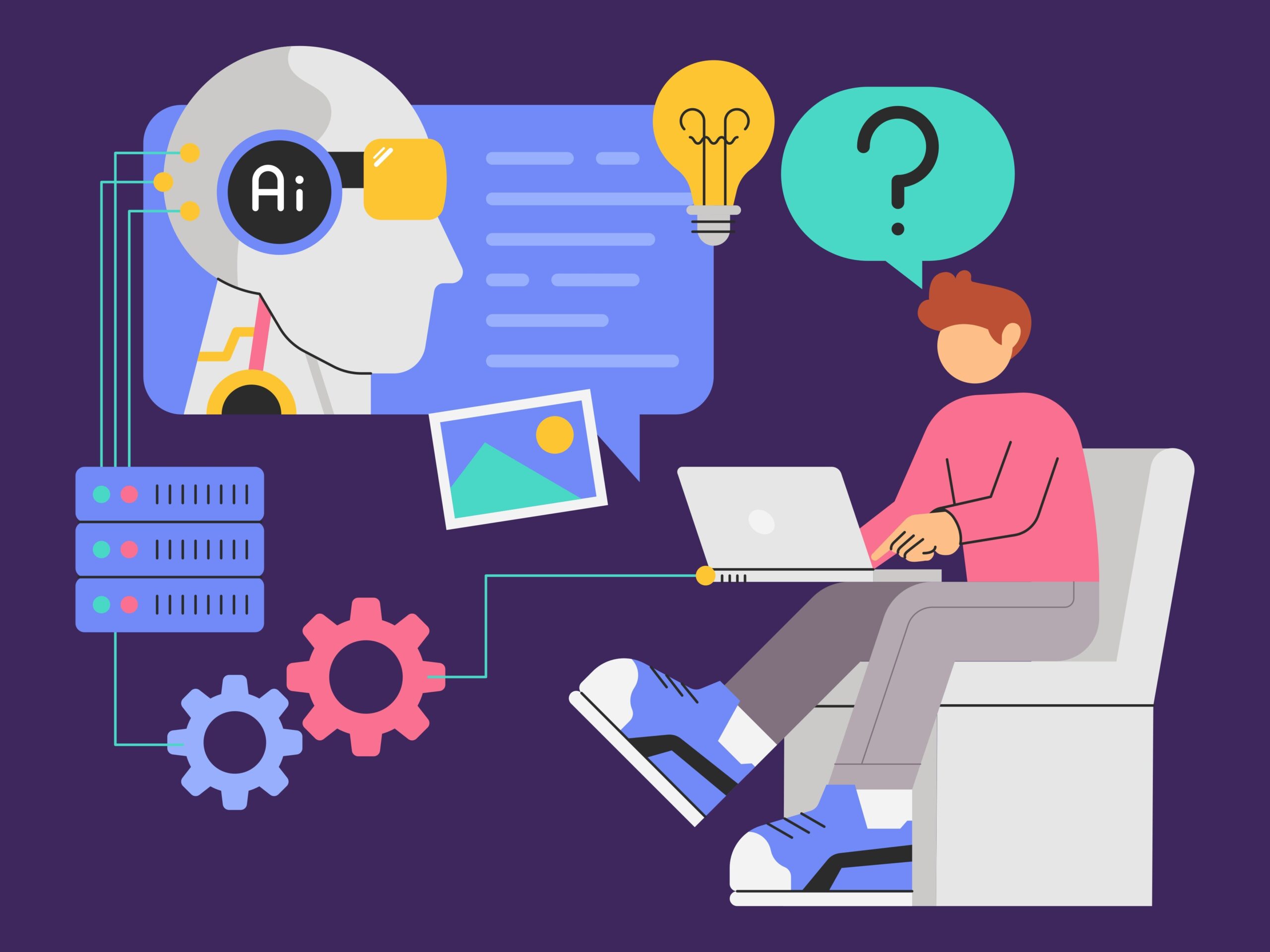
Section 1: From Reactive Bot to Proactive Partner: The Architecture of an AI Agent
The term “AI” gets thrown around a lot, but not all AI is created equal. To understand the power of an agentic tutor, we first need to distinguish it from its simpler cousins.
- Bots: These are the most basic, operating on pre-written scripts. Think of a simple FAQ chatbot on a website. It’s reactive and follows rules, but it doesn’t learn or plan.
- AI Assistants: A step up, these are tools like the large language models (LLMs) we’re now familiar with. You can ask them a question (“What are the themes in The Great Gatsby?”), and they’ll give you a comprehensive answer. However, they are still reactive; they wait for your command and don’t manage long-term goals.
- AI Agents: This is where the magic happens. An AI agent is proactive and goal-oriented. You can give it a complex objective like, “Help me prepare for my essay on symbolism in The Great Gatsby due next Friday,” and it will autonomously create and execute a multi-step plan. It might research critical articles, create a study schedule, generate flashcards, and even quiz you on themes, adapting its strategy based on your progress. It’s not just a tool; it’s a project manager for your learning.
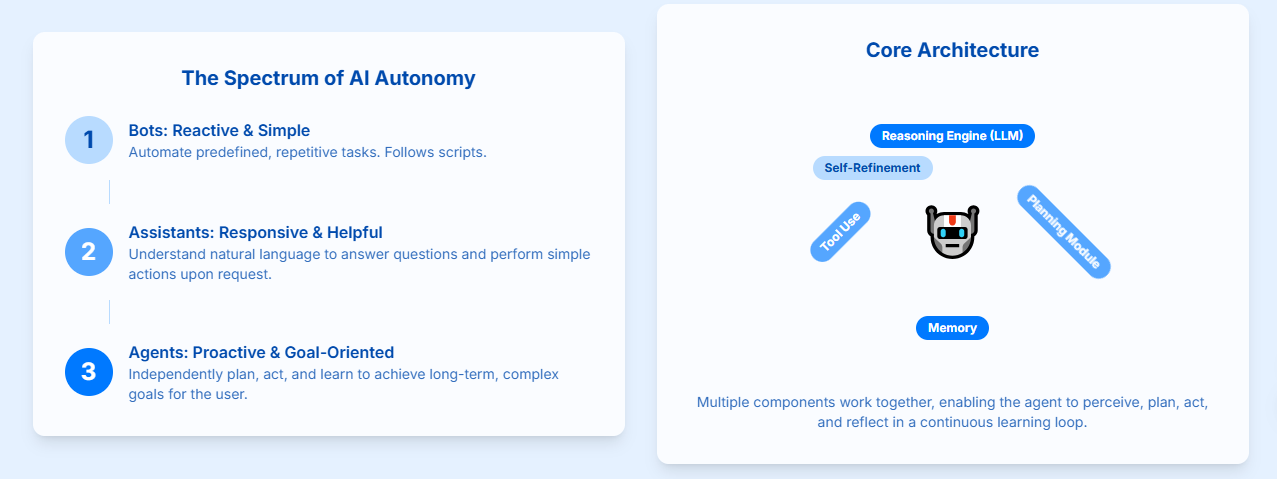
So, what gives these agents their advanced capabilities? It’s the synergy of several core components working together in a continuous loop.
- Foundation Model (The Brain): At its heart is a powerful LLM that provides the core reasoning, comprehension, and language generation abilities.
- Planning Module (The Strategist): This module takes your high-level goal and breaks it down into a logical sequence of smaller, actionable tasks.
- Memory Module (The Notebook): This is crucial for personalization. It includes short-term memory for the current conversation and long-term memory to store your goals, preferences, and past struggles. This is how the agent remembers you found a specific concept difficult last week.
- Tool Integration (The Toolbox): Agents aren’t confined to text. They can use external tools like searching the web for real-time information, running code, or scheduling study sessions in your calendar.
- Self-Refining Module (The Learner): The most advanced agents can learn from their interactions. By analyzing what works (e.g., you mastered a concept) and what doesn’t (e.g., you showed signs of frustration), they refine their own teaching strategies over time.
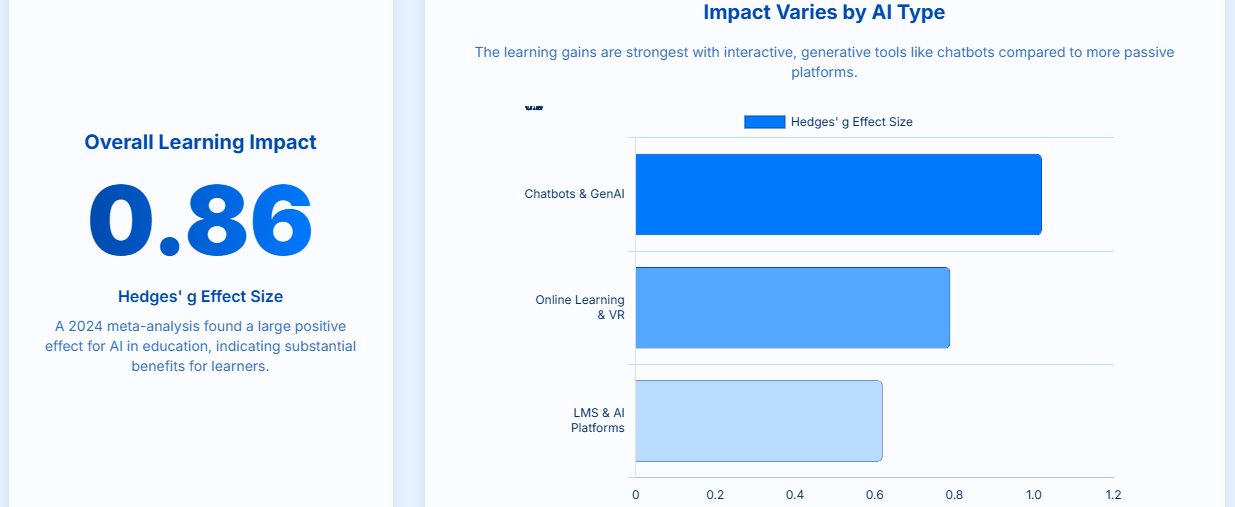
These components operate in a constant cycle: Perception → Planning → Action → Reflection. The agent perceives your needs, plans a course of action, executes it, and then reflects on the outcome to improve its next move. This turns learning from a static exchange into a dynamic, adaptive dialogue.
Section 2: The Agentic Tutor in the Wild: Real-World Applications
Theory is great, but where are these AI agents actually making an impact? They are being deployed as specialized tutors across a huge range of skills, from languages and coding to creative arts and communication.
The Rise of the AI Language Coach 🗣️
For language learners, the biggest hurdle is often a lack of consistent, low-stakes speaking practice. AI language coaches are solving this problem at scale.
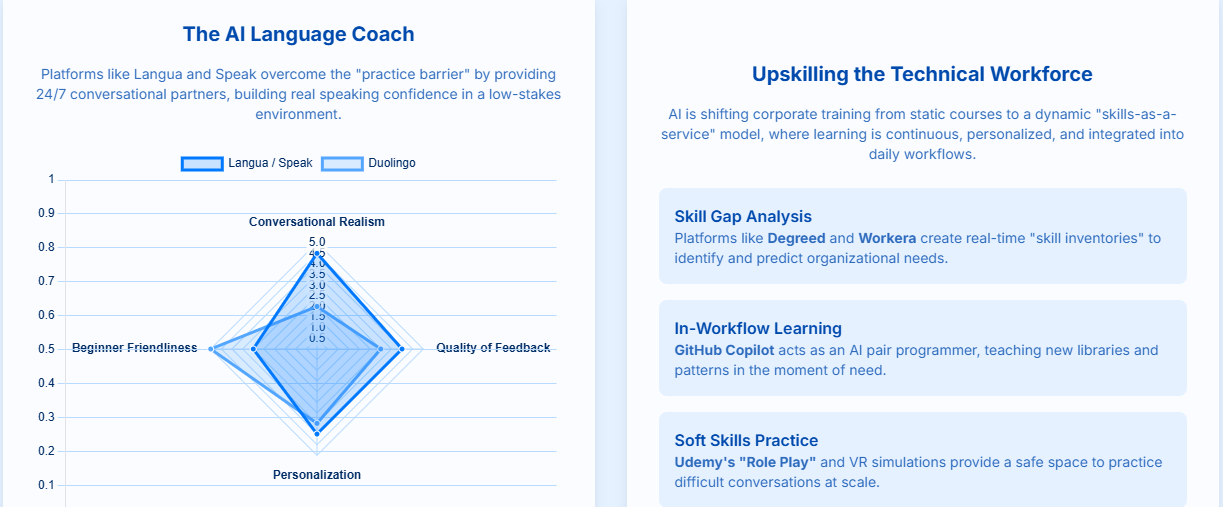
Platforms like Langua and Speak offer 24/7 conversational partners that simulate authentic, free-form discussions. You can practice without the fear of judgment that often comes with speaking to a human. They provide instant feedback on grammar and pronunciation and even track vocabulary you struggle with to re-introduce it in later conversations. This creates a powerful middle ground between basic vocabulary apps like Duolingo and expensive human tutors.
Platform |
Primary Focus |
Conversational Realism |
Key Feature |
Target User |
Langua |
Conversational Fluency |
High |
Spaced repetition flashcards, dialect selection |
Intermediate/Advanced |
Speak |
Speaking Practice |
High |
Real-time corrections with explanations |
Beginner to Advanced |
Duolingo |
Gamified Vocabulary |
Low |
Gamification and structured exercises |
Beginner |
Teacher AI |
Conversational Practice |
Medium-High |
Uses AI clones of real social media teachers |
Intermediate |
Upskilling the Technical Workforce 💻
In the fast-paced world of tech, skills become outdated quickly. AI agents are becoming critical infrastructure for continuous upskilling.
For corporations, platforms like Degreed and Workera use AI to map the skills of the entire workforce, identify critical gaps, and then automatically create personalized learning paths for each employee. Telecom giant Ericsson, for instance, used this approach to upskill 30,000 employees in AI—a feat impossible with traditional methods.
For individual developers, GitHub Copilot acts as an AI pair programmer, suggesting code, explaining complex functions, and helping with debugging directly within the workflow. This blurs the line between working and learning, providing just-in-time education exactly when it’s needed.
AI as a Catalyst for Creative and Soft Skills 🎨
Perhaps most surprisingly, AI is making inroads in areas once considered exclusively human.
- Creative Skills: Platforms like Skillshare are full of courses on using AI tools like Midjourney for inspiration and ChatGPT for brainstorming. Mainstream design software like Canva and Adobe have integrated AI features to handle tedious tasks like removing backgrounds or resizing graphics, freeing up creatives to focus on the big picture.
- Soft Skills: How do you practice a difficult conversation? With an AI! Udemy’s “Role Play” tool and Motive.io’s VR simulations allow users to practice high-stakes interpersonal situations—like giving constructive feedback or de-escalating a conflict—with an AI character in a safe, repeatable environment. The AI can even provide data-driven feedback on your tone of voice and word choice. This is a virtual “flight simulator for conversations” that could revolutionize corporate training and beyond.
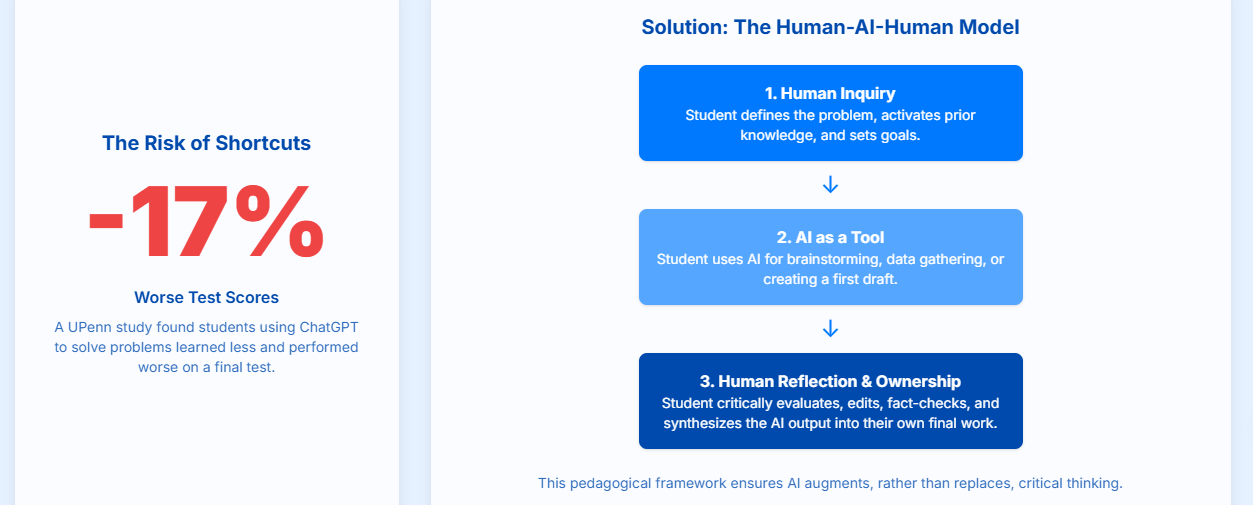
Section 3: A Critical Look: The Promise vs. The Peril
The potential of AI tutors is immense, but we must approach them with a healthy dose of critical optimism. It’s crucial to look at the evidence and acknowledge the risks.
The Evidence: Does It Actually Work?
A growing body of academic research says yes. Multiple large-scale meta-analyses have found that AI in education has a significant positive impact on learning outcomes.
- A 2024 meta-analysis found a large positive effect size (g=0.86), with chatbots and generative AI showing an exceptionally strong effect (g=1.02). In educational terms, an effect size this large is akin to boosting the average student’s performance by a full grade level.
- A landmark study from Stanford University found that when human tutors were given an AI assistant (“Tutor CoPilot”), their students were 4 to 9 percentage points more likely to master math problems. The AI acted as a real-time coach, helping the human tutors become more effective.
This reinforces a key theme: AI is most powerful when it augments human educators, not when it replaces them.
The Double-Edged Sword: Cognitive Engagement vs. Superficial Learning
Herein lies the biggest challenge. The very convenience of AI can undermine the learning process.
The risk is “cognitive off-loading”—becoming so dependent on AI to provide answers that we fail to develop our own critical thinking and problem-solving skills. The mental struggle is essential for deep learning, and bypassing it leads to fragile knowledge.
The evidence for this risk is also mounting. One striking experiment found that students who used ChatGPT to help with practice problems ultimately scored 17% worse on a final test than students who didn’t use AI. They got the right answers without truly learning the process.
This can lead to a dangerous dependency, eroding intellectual self-confidence and agency.
The Path Forward: A Human-Centered Approach
So, how do we get the benefits of AI without the pitfalls? The solution isn’t to ban the technology but to integrate it wisely.
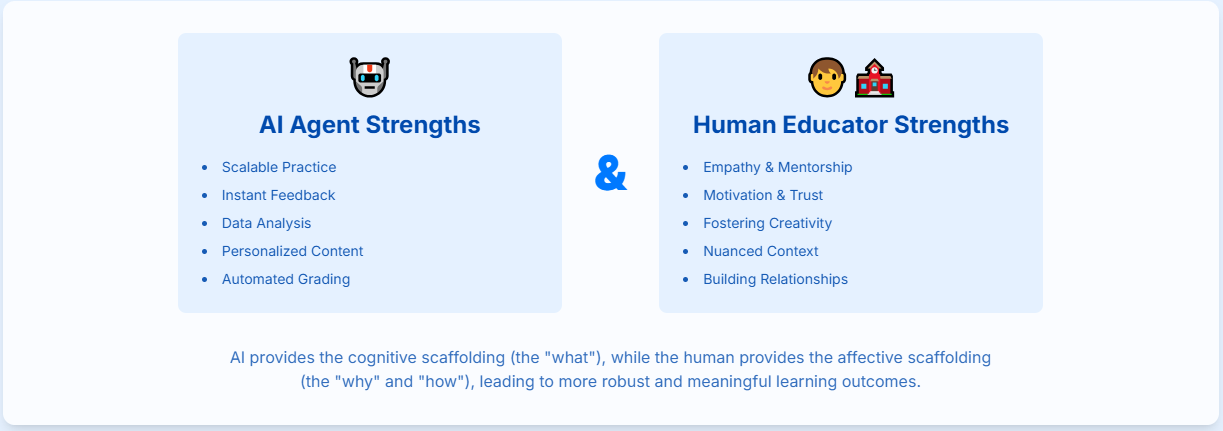
- Embrace the “Human-AI-Human” Model: Learning tasks should begin with Human Inquiry (defining the problem), use AI as a tool for brainstorming or data gathering, and always conclude with Human Reflection and ownership. The human must remain in the driver’s seat.
- Redesign Assessments: As AI can easily answer standard questions, assessments must evolve to measure higher-order skills like creativity, original analysis, and ethical reasoning.
- Address the Trust Deficit: AI tutors run on data, creating massive challenges around privacy and algorithmic bias. Educational institutions must establish strong governance to protect student data and conduct regular audits to ensure AI systems are not perpetuating or amplifying societal inequities.
- Value the Human Element: AI cannot replicate the empathy, mentorship, and motivational connection of a human teacher. The future of education lies in a hybrid model where AI handles the data-driven personalization and practice, freeing human educators to focus on the deeply human aspects of teaching: building relationships, fostering creativity, and providing emotional support.
The Agentic Tutor is here, and its capabilities will only grow. It holds the promise of a more equitable, personalized, and effective educational future for everyone. But realizing that promise requires us to be thoughtful architects of this new learning landscape, always ensuring that this powerful technology serves our most important human goal: the desire to learn, grow, and understand.


